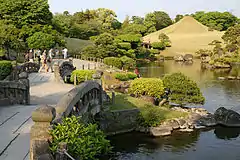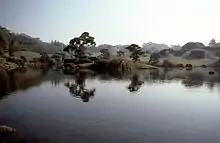Suizen-ji Jōju-en
Suizen-ji Jōju-en (水前寺成趣園) is a tsukiyama[1] Japanese garden located within Suizen-ji Park (水前寺公園, Suizen-ji Kōen) in Kumamoto Prefecture, Japan. The main tsukiyama is a representation of Mount Fuji. Lord Hosokawa Tadatoshi began construction of the garden in 1636 as a tea retreat. The park was named after a no-longer-extant Buddhist temple called Suizen-ji, and now hosts the Izumi Shrine, where members of the Hosokawa family are enshrined, and a Nōgaku-dō, a Noh theater. Lord Hosokawa selected this site because of its spring-fed pond, the clean water of which was excellent for tea.[2] The thatched Kokin-Denju-no-Ma teahouse was originally in Kyoto's Imperial Palace, but was moved here in 1912.
| Suizen-ji Jōju-en | |
|---|---|
| 水前寺成趣園 | |
 Suizen-ji Jōju-en

| |

| |
| Type | Japanese garden |
| Location | Kumamoto Prefecture, Japan |
| Coordinates | 32°47′28″N 130°44′05″E |
| Created | 1636 |
The garden has been declared by the national government a historic site of scenic beauty.
Suizenji Park
Suizenji Kōen is an interesting and much visited venue, featuring miniature landscapes, a temple and small lakes containing large, hungry, and multi-coloured carp. It is a short tram ride from the city. Nearby, there are many souvenir and snack shops.
See also
Gallery
 The pond
The pond The pond
The pond The Kokin-Denju-no-Ma teahouse
The Kokin-Denju-no-Ma teahouse The Yabusame (horseback archery) riding ground
The Yabusame (horseback archery) riding ground An arched bridge
An arched bridge Replica of Mount Fuji
Replica of Mount Fuji Izumi Shrine
Izumi Shrine A large carp in the park
A large carp in the park Statue of Hosokawa Tadatoshi
Statue of Hosokawa Tadatoshi

Notes
- Tsukiyama gardens are Japanese gardens featuring an artificial mountain (a tsukiyama).
- "Pylant, Don D. Japanese Gardening Organization - Suizenji Park". Botanysaurus. 2001-10-11. Archived from the original on 2010-09-03. Retrieved 2008-07-23.
References
- Explore Japan, Suizenji Garden accessed on August 31, 2009
| Wikimedia Commons has media related to Suizen-ji_Jōju-en. |
Bibliography
Mansfield, Stephen (2011). Japan's Master Gardens - Lessons in Space and Environment (Hardback). Tokyo, Rutland, Singapore: Tuttle. ISBN 978-4-8053-1128-8.